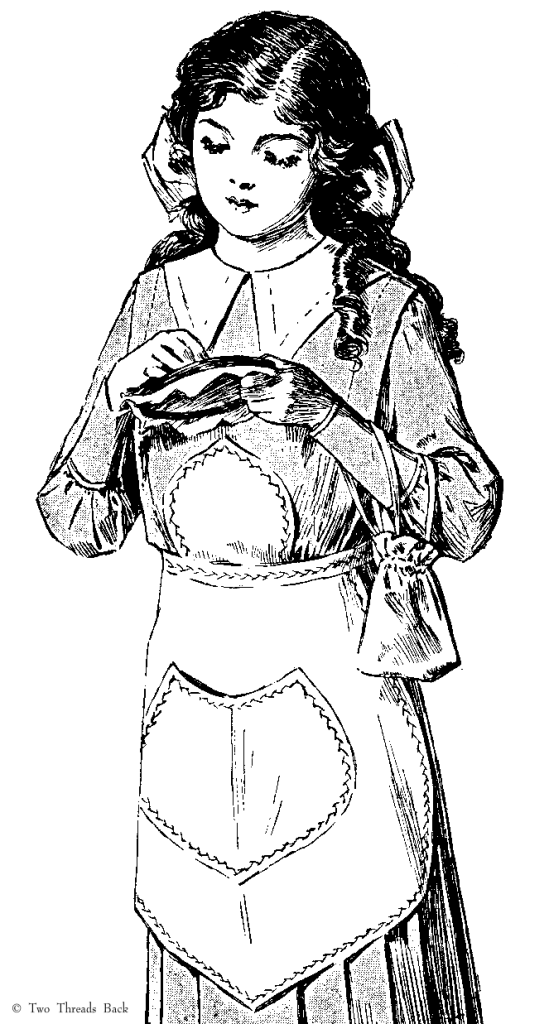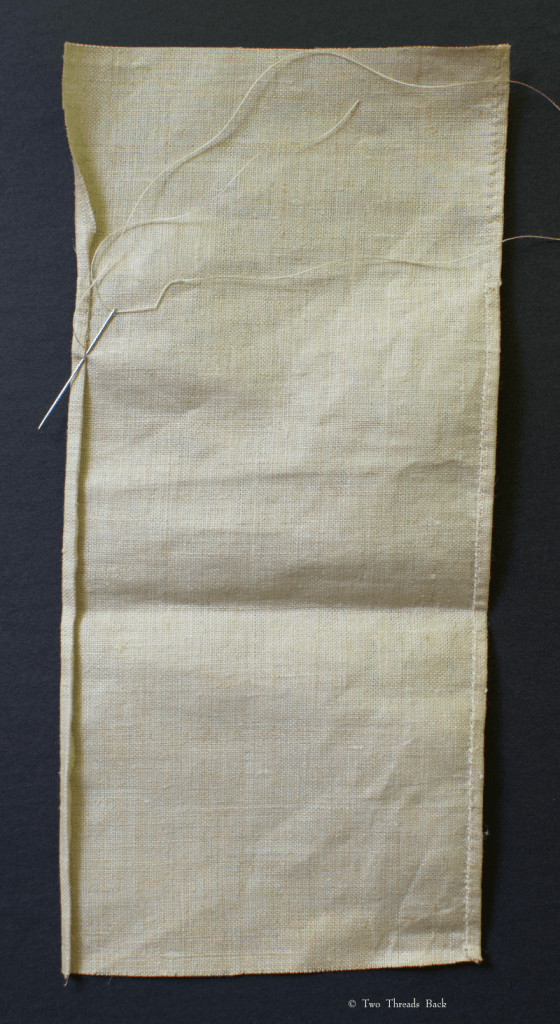
I don’t remember where I first came across the term “lap-bag.” It was used in the infuriatingly casual way that long-dead authors have of assuming we know what they’re talking about, and I didn’t give it much thought. But when I recently came across the illustration below, c.1860, my reaction was – in the words of my 4-year-old grandson – “what is the heck of that?”

Of course I pursued the elusive lap-bag, only to discover it wasn’t so peculiar after all. It has a respectable history, especially if you consider it’s only a variation on a very useful, very humble, and very common garment. I think this young emigrant to Australia summed it up perfectly in 1850:
The ladies gave me a nice piece of print to make a lap-bag, which will be very handy on board ship, as it ties round the waist, and has little pockets to hold one’s thimble and scissors.
It’s simply a type of pocketed apron that was used for keeping sewing items handy, something especially helpful for girls’ sewing classes. The pinafore was another variation, recommended as early as the 1810s for plain needlework lessons, both in England and America.
Each girl should be provided with a pin-afore, or slip … taken in at the conclusion of school time…. The pin-afores are marked 1, 2, 3, &c. up to the number of girls that the desk contains: the number of the desk is also marked upon them, thus – 5/3, which would signify that the pin-afore belongs to the 5th girl in the third desk.
In 1858, when Alice Neal penned her reminiscences of Eliza Leslie for Godey’s Lady’s Book, she remembered her own school days.
As long ago as sewing was made a special branch of female education – and we leave our readers to infer the date [she was born in 1828] – the Wednesday afternoons at the school which I attended in Boston were enlivened by reading aloud. The circle of little people, with their pink and blue chintz “lap-bags,” a style of sewing receptacle entirely unique, stitched away on their sheets and patchwork, while the older girls read in turn.
A children’s story from 1871 tells how “The girls all had to be provided with lap-bags, worn like aprons, with the ends brought up and stitched together. These were to keep the work from getting soiled, and hold the thimble, cotton, needles, scissors, etc.” School inventories included lap-bags, and one teacher explained,
These little lap-bags,” remarked the teacher, are the very first articles I teach the children in the Primary class to make; and they use them through all the grades until they graduate from the cutting department. Each bag is labelled, and at the close of the sewing hour the work is neatly rolled up, put inside, then collected in these large baskets.
Some later sources called them sewing aprons, but these matched the description as being aprons “made of extra length to allow the turning up of a quarter yard or so for a pocket.” After reading all about these receptacles, I decided to attempt my own. It’s quicker and cheaper to make things in miniature, so doll size it would be!
But what to use? I found references to brown holland (unbleached linen), calico prints, Scotch gingham (a better quality gingham), and pink and blue chintz. My obsession with charity sewing schools inclined me toward the brown holland, since that was the utility fabric they suggested. I just happily happened to have a bit of it with the original glaze (a glossy sizing) remaining, so the next step was to make sense of the directions that accompanied the illustration. Simple. For most people.



Next came the marking. As much as I wanted to follow advice and place the numbers where they’d show when the work was folded, I couldn’t make it work. But my doll will still take her place as the “fifth girl in the third row.”

Trust writers of the era to impart moral virtue into anything that would hold it. I don’t mind, at least not when they’re praising hand sewing.
If it is best to train the child along aesthetic lines in any phase of art, then let him be trained to appreciate and prefer a piece of true art in needle-work, even plain sewing, over a wholesale manufactured article which may be bought at cheap rates.
Let me illustrate by a school girl’s sewing apron, neatly though plainly made, hand-sewed by herself, and appreciated because she wove into its very stitches her own power and love of doing a thing for herself, and, too, having done it the best she could, over a very elaborate one selected from a whole boxful in a store marked “your choice for 10c.”
As aesthetic development and culture help to make a person a better person, so sewing can be made to help a girl to become a better girl and a more powerful and valuable woman to society.
Why not turn up your nose at that 10¢ store-bought apron, make your own, and become a powerful woman! You’ll be glad you did.


Love this! Thanks so much for posting.
LikeLike
Thank you so much! I’m always happy when a post pleases! 😉
LikeLike
I am glad your dolly now has a new sewing receptacle, and so beautifully sewn, labelled and pin-cushioned! I trust she will not have any need for the punishment badge…and very glad your grandson now knows what the heck is of that!
LikeLiked by 1 person
Delightful! I knew nothing of these—& they are so simply but charmingly constructed.
I totally identify with directional challenges of sewing: the”inside-outside, outside-inside”-ness that catches me so often!
Thank you 😊
LikeLiked by 1 person
Your doll must be very happy with her very practical and pretty new lap-bag. I’m completely lost without pockets – the bigger the better. Both my mother and grandmother have taught me to make huge ones for aprons but I might just have to make myself one of these clever lap-bags too 😀
LikeLike
I can’t imagine life without pockets either! Although my washer and dryer have eaten the contents of a few over the years. 😉
LikeLiked by 1 person